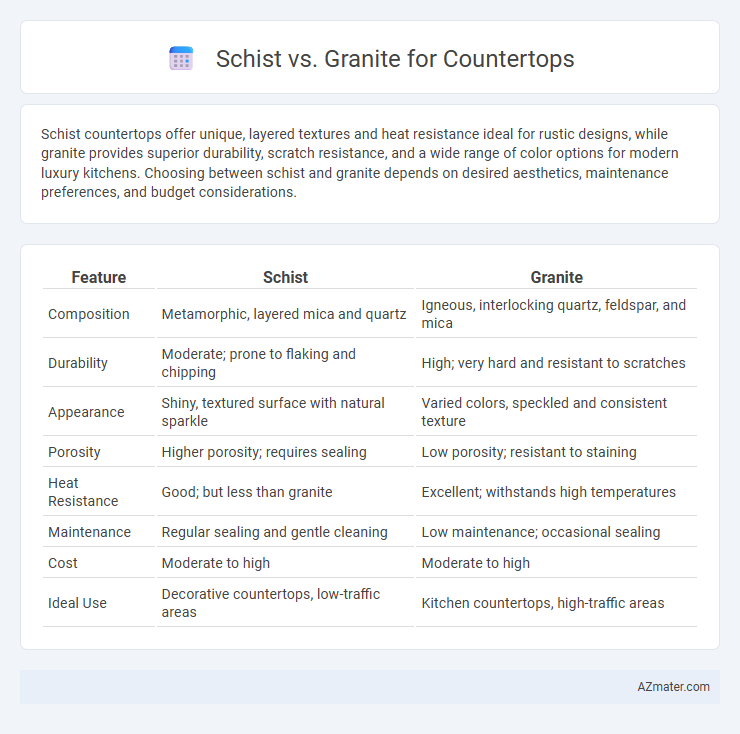Schist countertops offer unique, layered textures and heat resistance ideal for rustic designs, while granite provides superior durability, scratch resistance, and a wide range of color options for modern luxury kitchens. Choosing between schist and granite depends on desired aesthetics, maintenance preferences, and budget considerations.
Table of Comparison
| Feature | Schist | Granite |
|---|---|---|
| Composition | Metamorphic, layered mica and quartz | Igneous, interlocking quartz, feldspar, and mica |
| Durability | Moderate; prone to flaking and chipping | High; very hard and resistant to scratches |
| Appearance | Shiny, textured surface with natural sparkle | Varied colors, speckled and consistent texture |
| Porosity | Higher porosity; requires sealing | Low porosity; resistant to staining |
| Heat Resistance | Good; but less than granite | Excellent; withstands high temperatures |
| Maintenance | Regular sealing and gentle cleaning | Low maintenance; occasional sealing |
| Cost | Moderate to high | Moderate to high |
| Ideal Use | Decorative countertops, low-traffic areas | Kitchen countertops, high-traffic areas |
Introduction to Schist and Granite Countertops
Schist countertops, known for their distinctive foliated texture and natural sheen, offer a unique aesthetic with durable mineral composition primarily consisting of mica, quartz, and feldspar. Granite countertops are prized for their strength, hardness, and resistance to heat and scratches, formed from interlocking crystals of quartz, feldspar, and mica within an igneous rock matrix. Both materials provide longevity and visual appeal, with schist showcasing layered elegance and granite delivering a classic, robust surface for kitchen and bathroom installations.
Geological Composition and Formation
Schist countertops derive from metamorphic rock characterized by abundant mica minerals such as biotite and muscovite, formed under moderate to high temperatures and pressures during regional metamorphism. Granite consists of coarse-grained igneous rock primarily composed of quartz, feldspar, and mica, crystallizing slowly from molten magma deep within the Earth's crust. The distinct formation processes result in schist's foliated texture and layered appearance, contrasting with granite's granular, interlocking mineral structure that impacts durability and aesthetic appeal in countertop applications.
Appearance and Aesthetic Differences
Schist countertops exhibit a distinctive foliated texture with visible mineral grains like mica and quartz, offering a shimmering, layered appearance that adds natural elegance and warmth to kitchen designs. Granite countertops feature a more uniform, granular texture with a wide range of colors and intricate speckling patterns, providing a classic, polished look that complements both traditional and modern aesthetics. The natural variations in schist create a unique, rustic charm, while granite's consistent durability and visual appeal make it a popular choice for sleek, high-end countertops.
Durability and Strength Comparison
Schist countertops offer notable durability due to their foliated texture, but granite surpasses schist in overall strength and resistance to chipping or cracking. Granite's interlocking crystal structure provides exceptional hardness, making it more resistant to heavy impacts and scratches in high-traffic kitchen environments. Both stones require sealing for stain resistance, yet granite's superior density ensures longer-lasting durability under frequent use.
Maintenance Requirements
Schist countertops demand regular sealing due to their natural porosity, making them more susceptible to stains and moisture compared to granite. Granite surfaces are more durable and require less frequent sealing, often only once a year, thanks to their dense, non-porous composition. Proper maintenance for both materials includes routine cleaning with pH-neutral solutions to preserve surface integrity and prevent damage.
Cost Considerations
Schist countertops typically cost between $50 to $100 per square foot, making them a mid-range option compared to granite, which ranges from $40 to $200 per square foot depending on color, rarity, and thickness. Installation charges for both materials vary but tend to be higher for granite due to its density and hardness, requiring specialized labor and equipment. Long-term maintenance costs differ as schist is softer and more prone to scratching and chipping, potentially increasing repair and sealing expenses over time compared to more durable granite surfaces.
Heat and Stain Resistance
Granite countertops offer superior heat resistance, withstanding high temperatures up to 1200degF without damage, making them ideal for kitchen use near stoves and ovens. Schist, while visually appealing due to its natural crystalline texture, is less heat resistant and may suffer discoloration or surface damage when exposed to high temperatures. Both materials provide good stain resistance, but granite's dense, non-porous structure typically requires less sealing and maintenance to prevent staining from oils, acids, and liquids compared to the more porous schist.
Environmental Impact and Sustainability
Schist countertops, made from natural metamorphic rock, tend to have a lower environmental impact due to less energy-intensive quarrying and processing compared to granite, which requires more intensive mining and polishing techniques. Granite's extraction often leads to significant habitat disruption and increased carbon emissions, while schist is typically sourced from smaller quarries with reduced ecological footprint. Choosing schist supports sustainability by utilizing a more abundant, locally available material that minimizes energy consumption and promotes environmentally responsible construction practices.
Best Applications in Kitchen and Bathroom Design
Schist countertops, known for their unique foliated texture and natural shine, excel in kitchen applications where aesthetic appeal and moderate durability are priorities, but they require sealing to resist moisture and staining. Granite offers superior hardness and heat resistance, making it ideal for high-traffic kitchen surfaces and bathroom vanities that demand longevity and low maintenance. Both materials can enhance design, with granite providing a more uniform look and schist delivering distinctive natural patterns suitable for accent pieces.
Choosing the Right Material: Schist or Granite?
Schist countertops offer a unique, textured appearance with natural mica flakes that enhance kitchen aesthetics, while granite provides superior durability and resistance to scratches and heat, making it ideal for heavy-duty use. When choosing between schist and granite, consider maintenance needs--schist requires regular sealing to prevent staining, whereas granite is more forgiving and easier to maintain. Assess your kitchen's style and workload to determine if the earthy, sparkling appeal of schist or the classic, robust qualities of granite best match your countertop requirements.

Infographic: Schist vs Granite for Countertop
 azmater.com
azmater.com